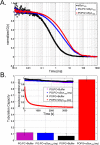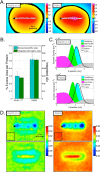α-Synuclein-induced membrane remodeling is driven by binding affinity, partition depth, and interleaflet order asymmetry
- PMID: 24960410
- PMCID: PMC4105054
- DOI: 10.1021/ja5016958
α-Synuclein-induced membrane remodeling is driven by binding affinity, partition depth, and interleaflet order asymmetry
Abstract
We have investigated the membrane remodeling capacity of the N-terminal membrane-binding domain of α-synuclein (α-Syn100). Using fluorescence correlation spectroscopy and vesicle clearance assays, we show that α-Syn100 fully tubulates POPG vesicles, the first demonstration that the amphipathic helix on its own is capable of this effect. We also show that at equal density of membrane-bound protein, α-Syn has dramatically reduced affinity for, and does not tubulate, vesicles composed of a 1:1 POPG:POPC mixture. Coarse-grained molecular dynamics simulations suggested that the difference between the pure POPG and mixture results may be attributed to differences in the protein's partition depth, the membrane's hydrophobic thickness, and disruption of acyl chain order. To explore the importance of these attributes compared with the role of the reduced binding energy, we created an α-Syn100 variant in which we removed the hydrophobic core of the non-amyloid component (NAC) domain and tested its impact on pure POPG vesicles. We observed a substantial reduction in binding affinity and tubulation, and simulations of the NAC-null protein suggested that the reduced binding energy increases the protein mobility on the bilayer surface, likely impacting the protein's ability to assemble into organized pretubule structures. We also used simulations to explore a potential role for interleaflet coupling as an additional driving force for tubulation. We conclude that symmetry across the leaflets in the tubulated state maximizes the interaction energy of the two leaflets and relieves the strain induced by the hydrophobic void beneath the amphipathic helix.
Figures







Similar articles
-
α-Synuclein's Uniquely Long Amphipathic Helix Enhances its Membrane Binding and Remodeling Capacity.J Membr Biol. 2017 Apr;250(2):183-193. doi: 10.1007/s00232-017-9946-1. Epub 2017 Feb 26. J Membr Biol. 2017. PMID: 28239748 Free PMC article.
-
A coarse-grained approach to studying the interactions of the antimicrobial peptides aurein 1.2 and maculatin 1.1 with POPG/POPE lipid mixtures.J Mol Model. 2018 Jul 17;24(8):208. doi: 10.1007/s00894-018-3747-z. J Mol Model. 2018. PMID: 30019106
-
Polyunsaturated Fatty Acid Modulates Membrane-Bound Monomeric α-Synuclein by Modulating Membrane Microenvironment through Preferential Interactions.ACS Chem Neurosci. 2021 Feb 17;12(4):675-688. doi: 10.1021/acschemneuro.0c00694. Epub 2021 Feb 4. ACS Chem Neurosci. 2021. PMID: 33538574
-
Solid-state nuclear magnetic resonance relaxation studies of the interaction mechanism of antimicrobial peptides with phospholipid bilayer membranes.Biochemistry. 2005 Aug 2;44(30):10208-17. doi: 10.1021/bi050730p. Biochemistry. 2005. PMID: 16042398
-
Alpha-synuclein association with phosphatidylglycerol probed by lipid spin labels.Biochemistry. 2003 Nov 11;42(44):12919-26. doi: 10.1021/bi035048e. Biochemistry. 2003. PMID: 14596606
Cited by
-
α-Synuclein's Uniquely Long Amphipathic Helix Enhances its Membrane Binding and Remodeling Capacity.J Membr Biol. 2017 Apr;250(2):183-193. doi: 10.1007/s00232-017-9946-1. Epub 2017 Feb 26. J Membr Biol. 2017. PMID: 28239748 Free PMC article.
-
Cooperation of Helix Insertion and Lateral Pressure to Remodel Membranes.Biomacromolecules. 2019 Mar 11;20(3):1217-1223. doi: 10.1021/acs.biomac.8b01606. Epub 2019 Feb 20. Biomacromolecules. 2019. PMID: 30653915 Free PMC article.
-
The Effects of Lipids on α-Synuclein Aggregation In Vitro.Biomolecules. 2023 Oct 2;13(10):1476. doi: 10.3390/biom13101476. Biomolecules. 2023. PMID: 37892158 Free PMC article. Review.
-
An N-terminal conserved region in human Atg3 couples membrane curvature sensitivity to conjugase activity during autophagy.Nat Commun. 2021 Jan 14;12(1):374. doi: 10.1038/s41467-020-20607-0. Nat Commun. 2021. PMID: 33446636 Free PMC article.
-
Molecular details of α-synuclein membrane association revealed by neutrons and photons.J Phys Chem B. 2015 Apr 9;119(14):4812-23. doi: 10.1021/jp512499r. Epub 2015 Apr 1. J Phys Chem B. 2015. PMID: 25790164 Free PMC article.
References
-
- Robotta M.; Braun P.; van Rooijen B.; Subramaniam V.; Huber M.; Drescher M. ChemPhysChem 2011, 12, 267. - PubMed
Publication types
MeSH terms
Substances
Grants and funding
LinkOut - more resources
Full Text Sources
Other Literature Sources
Miscellaneous

